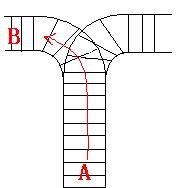Train Problem I
Time Limit: 2000/1000 MS (Java/Others) Memory Limit: 65536/32768 K (Java/Others)Total Submission(s): 20521 Accepted Submission(s): 7712
Problem Description
As the new term comes, the Ignatius Train Station is very busy nowadays. A lot of student want to get back to school by train(because the trains in the Ignatius Train Station is the fastest all over the world ^v^). But here comes a problem, there is only one
railway where all the trains stop. So all the trains come in from one side and get out from the other side. For this problem, if train A gets into the railway first, and then train B gets into the railway before train A leaves, train A can't leave until train
B leaves. The pictures below figure out the problem. Now the problem for you is, there are at most 9 trains in the station, all the trains has an ID(numbered from 1 to n), the trains get into the railway in an order O1, your task is to determine whether the
trains can get out in an order O2.






Input
The input contains several test cases. Each test case consists of an integer, the number of trains, and two strings, the order of the trains come in:O1, and the order of the trains leave:O2. The input is terminated by the end of file. More details in the Sample
Input.
Output
The output contains a string "No." if you can't exchange O2 to O1, or you should output a line contains "Yes.", and then output your way in exchanging the order(you should output "in" for a train getting into the railway, and "out" for a train getting out of
the railway). Print a line contains "FINISH" after each test case. More details in the Sample Output.
Sample Input
3 123 321 3 123 312
Sample Output
Yes. in in in out out out FINISH No. FINISHFor the first Sample Input, we let train 1 get in, then train 2 and train 3. So now train 3 is at the top of the railway, so train 3 can leave first, then train 2 and train 1. In the second Sample input, we should let train 3 leave first, so we have to let train 1 get in, then train 2 and train 3. Now we can let train 3 leave. But after that we can't let train 1 leave before train 2, because train 2 is at the top of the railway at the moment. So we output "No.".HintHint
Author
Ignatius.L
栈的水题一道。就直接对进出栈进行模拟。和之前做的那道题类似,用来练练STL还是不错的,直接用STL水过。
http://blog.csdn.net/whjkm/article/details/38455291 能够看看之前的那道题。
用来vector 和 stack容器。用vector来存储字符串;
#include <cstdio>
#include <cstring>
#include <string>
#include <iostream>
#include <stack>
#include <vector>
using namespace std;
int main()
{
int n,i,j;
string str1,str2;
while(cin>>n>>str1>>str2)
{
stack<int>s;
vector<string>v;
for(i=0,j=0;i<n&&j<n;i++)
{
s.push(str1[i]);//把元素进栈
v.push_back("in");//压进vector容器
while(s.top()==str2[j])//进行匹配
{
if(!s.empty())
{
s.pop();
v.push_back("out");
}
j++;
if(s.empty()) break;
}
}
if(j==n)
{
printf("Yes.
");
for(i=0; i< v.size();i++)
cout<< v[i] <<endl;
printf("FINISH
");
}
else
printf("No.
FINISH
");
}
return 0;
}